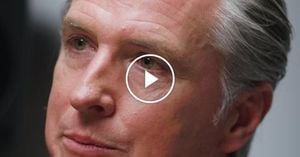The latest jobs report for September 2025 has sparked urgent calls for federal action, as new data paints a troubling picture for Black women in the U.S. workforce. On November 20, 2025, the Bureau of Labor Statistics (BLS) released the delayed September numbers after a government shutdown, revealing a national unemployment rate of 4.4%—the highest since September 2021. But beneath that headline figure lies an even starker reality: Black women are being hit hardest, with unemployment for this group surging to 7.5% and their average spell of joblessness stretching to 18.5 weeks. These numbers, according to a Center for American Progress analysis, underscore a crisis that has been building for months and now threatens to reverberate throughout the broader economy.
Congresswoman Ayanna Pressley (MA-07), a member of the House Financial Services Committee, has been among the most vocal leaders sounding the alarm. In a statement issued the same day as the report’s release, Pressley declared, "These numbers are damning and confirm what we’ve long known to be true: under Donald J. Trump, Black women continue to face a crisis of disproportionately high unemployment—a direct result of Trump’s reckless mass firings, a growing affordability crisis, and relentless attacks on diversity, equity, inclusion and accessibility initiatives." Pressley’s words echo the findings of multiple economic analyses, which show that people of color, especially Black men and women, are experiencing greater difficulty finding work in the current economy.
It’s not just the rate of joblessness that’s concerning. The duration of unemployment is climbing as well. In September, the median unemployed American spent 10 weeks searching for work—up from the previous year. But for Black women, the typical period out of work soared to 18.5 weeks, a full 7.5 weeks longer than in 2024 and more than eight weeks longer than their white male counterparts, according to BLS data. This extended duration means many are nearing or surpassing the cutoff for unemployment benefits, which in some states lasts less than the standard 26 weeks. For primary breadwinners—roles Black women disproportionately fill—this spells growing financial insecurity for entire families.
The labor force participation rate for Black women also slipped from 62.4% in January 2025 to 61.9% in September. While that half-point drop might seem minor at first glance, it represents thousands of women leaving the workforce, often out of discouragement over bleak job prospects. In fact, 537,000 people in total left the labor force in September due to discouragement, a jump of 20% from the previous year. According to BLS, this group now accounts for nearly a third of those not in the labor force but who still want a job.
Job seekers across the board are facing a tougher market. The number of job openings in October 2025 fell to the lowest level since February 2021, and hiring rates in August dropped to a pre-pandemic low of 3.5%—a level not seen since January 2011. As employers pull back on hiring in the face of economic uncertainty, opportunities are drying up, especially for those already at a disadvantage. For Black women, who often face both racial and gender-based barriers in the job market, these trends are particularly worrisome.
The impact is compounded by the limitations of the unemployment insurance (UI) system. In July 2025, the average weekly benefit was $458.80, replacing just 37% of lost wages on average. But there’s wide variation: some states replace as little as 27.4% of previous earnings, resulting in weekly checks as low as $305.34. In 33 states and the District of Columbia, UI replaces less than half of former wages, leaving many households struggling to make ends meet. As Pressley noted, "As the primary breadwinners for many households, Black women are the backbones of our families and our economy, and their systematic pushout not only has dangerous consequences for Black women, Black families, Black futures—it is also a glaring red flag for the entire U.S. economy."
Pressley has been relentless in her advocacy, demanding urgent action from both the Federal Reserve and the Department of Labor. In September, she wrote to Federal Reserve Chairman Jerome Powell, urging immediate steps to uphold the Fed’s mandate of maximum employment for all Americans. She also convened a press conference with Black women activists and civil rights leaders to highlight the crisis and rally support for solutions. Among her proposals: a historic resolution calling for a federal job guarantee, co-sponsorship of the American Opportunity Accounts Act (popularly known as "Baby Bonds," which would create a federally funded savings account for every American child to help close the racial wealth gap), and introduction of the Equity in Government Act to codify racial equity across federal agencies.
Pressley’s efforts build on the legacy of Black women in the civil rights movement and reflect a broader push for race-conscious economic policies. She has also called on the nation’s largest banks to provide updates on their racial equity commitments made after the murder of George Floyd in 2020. Her advocacy extends to student debt relief as well; following years of pressure from Pressley and allies like the NAACP, the Biden-Harris Administration announced a plan to cancel student debt for over 40 million Americans.
Yet, the September jobs report suggests these efforts face headwinds from federal economic policy. Since Trump took office, the overall unemployment rate has ticked up by 0.4 percentage points, and the Federal Reserve projects it will remain elevated into 2026. The current administration’s mass federal workforce layoffs and what critics call "anti-DEI" (diversity, equity, and inclusion) policies are seen by many, including Pressley, as disproportionately harming Black women. The Congresswoman has gone so far as to accuse Trump of attempting to "seize control of the Fed by illegally firing Federal Reserve Governor Lisa Cook," a move she argues would further undermine economic stability and equity.
Economists often refer to Black unemployment as the "canary in the coalmine" for the health of the labor market. When Black workers face rising unemployment and longer job searches, it’s often a warning sign that the rest of the workforce could soon face similar struggles. With the typical unemployed worker now spending nearly three months job hunting, and with job openings and hiring rates at multi-year lows, the outlook for the remainder of 2025 appears challenging at best.
As the year winds down and further jobs data is awaited, advocates like Pressley continue to press for policy changes to address what she calls a "crisis of disproportionately high unemployment" among Black women. Whether Washington will heed the call remains to be seen. For now, the numbers tell a sobering story—one that families across the country are living every day.




